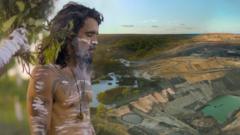In central Queensland, a ceremonial fire has been burning for more than 1,300 days, symbolizing the relentless protest by the Wangan and Jagalingou (W&J) people against the controversial Carmichael coal mine, operated by the Indian conglomerate Adani, known locally as Bravus. This site of resistance sits near Doongmabulla Springs, a sacred resource viewed as vital by Indigenous Australians.
Adrian Burragubba and his son Coedie McAvoy lead the movement to protect these springs, believing them to be created by the ancestral rainbow serpent Mundagudda. "Where my land is, there's a mine trying to destroy my country," Adrian declares, asserting that the land embodies his history and cultural identity.
The springs, integral to an underground water system vital for the region, lie above the Galilee Basin, one of the largest untouched coal reserves globally. Concerns have been raised by scientists like Professor Matthew Currell, revealing hydrocarbons in the spring waters, indicating potential contamination linked to mining activities. "If it's linked to mining," Currell warns, "then it's a red flag that the spring water quality is imminently under threat," compelling a re-evaluation of the mine's environmental assessments.
Adani rebuffed these claims, arguing its compliance with environmental regulations, and is currently contesting a government-imposed ban on further underground mining. While the Queensland Environment Minister affirmed the state’s commitment to safeguard these springs, the conflict has highlighted deep divisions within the W&J community regarding the mine's impact and benefits.
The situation has broader implications, touching on Indigenous rights as defined by the 2007 UN Declaration on the Rights of Indigenous Peoples, which necessitates obtaining consent from Indigenous groups for land-use projects. Yet the Queensland government previously authorized the mine project, inadvertently deepening community rifts.
The mine has also ignited fierce national debate over coal's role in Australia's energy future, with proponents citing job creation against growing environmental concerns. Allegations of poor labor conditions have surfaced from workers at Bravus, although the company maintains safety standards.
Displacement and historical injustices weigh heavily on the W&J people, who have faced dispossession since the 1915 Aboriginal Protection Act. Though the Native Title Act later granted limited rights, recent legal battles have seen W&J's claims dismissed, stripping them of consultation rights.
Now, with hopes pinned on a judicial review in the Queensland Supreme Court, Adrian argues the mine infringes on his community's human rights by threatening their sacred lands. His case could serve as a landmark decision for Indigenous people across Australia seeking to safeguard their culture and environment. Despite previous court losses and personal bankruptcy, Adrian and his allies remain steadfast in their fight for the water and land that they believe define their existence.
Adrian Burragubba and his son Coedie McAvoy lead the movement to protect these springs, believing them to be created by the ancestral rainbow serpent Mundagudda. "Where my land is, there's a mine trying to destroy my country," Adrian declares, asserting that the land embodies his history and cultural identity.
The springs, integral to an underground water system vital for the region, lie above the Galilee Basin, one of the largest untouched coal reserves globally. Concerns have been raised by scientists like Professor Matthew Currell, revealing hydrocarbons in the spring waters, indicating potential contamination linked to mining activities. "If it's linked to mining," Currell warns, "then it's a red flag that the spring water quality is imminently under threat," compelling a re-evaluation of the mine's environmental assessments.
Adani rebuffed these claims, arguing its compliance with environmental regulations, and is currently contesting a government-imposed ban on further underground mining. While the Queensland Environment Minister affirmed the state’s commitment to safeguard these springs, the conflict has highlighted deep divisions within the W&J community regarding the mine's impact and benefits.
The situation has broader implications, touching on Indigenous rights as defined by the 2007 UN Declaration on the Rights of Indigenous Peoples, which necessitates obtaining consent from Indigenous groups for land-use projects. Yet the Queensland government previously authorized the mine project, inadvertently deepening community rifts.
The mine has also ignited fierce national debate over coal's role in Australia's energy future, with proponents citing job creation against growing environmental concerns. Allegations of poor labor conditions have surfaced from workers at Bravus, although the company maintains safety standards.
Displacement and historical injustices weigh heavily on the W&J people, who have faced dispossession since the 1915 Aboriginal Protection Act. Though the Native Title Act later granted limited rights, recent legal battles have seen W&J's claims dismissed, stripping them of consultation rights.
Now, with hopes pinned on a judicial review in the Queensland Supreme Court, Adrian argues the mine infringes on his community's human rights by threatening their sacred lands. His case could serve as a landmark decision for Indigenous people across Australia seeking to safeguard their culture and environment. Despite previous court losses and personal bankruptcy, Adrian and his allies remain steadfast in their fight for the water and land that they believe define their existence.






















